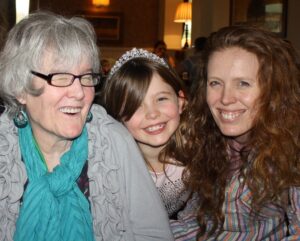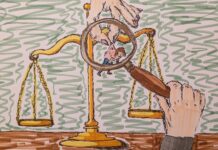When my daughter, Connie, was a toddler, I held her on my hip and we spun around the living room dancing to “I Wanna Be Like You” from the 1960s film “The Jungle Book.” It was a moment of pure joy and togetherness, so it felt alien to notice my stomach churning. Although I couldn’t understand the feeling back then, I recognise it now as grief. I missed my mum. We hadn’t had moments like these. We couldn’t. During my early years, Mum had been in and out of psychiatric wards. I grew up with explanations for her absence that included the phrases “chemical imbalance” and “manic depression.” I bought into them and therefore accepted that her treatment required ECT, psychiatric drugs, and separation from me. I even accepted that such treatment would be lifelong because, as I was led to believe, there was no cure for biological “disorders” like hers.
I accepted it all, until, as a young mum, I spun between sofas with my own precious baby and a throbbing gut. Suddenly, I saw a flash of the nearby Humber Bridge in my mind’s eye. I felt my stomach lurch in that dropping sensation you get on a rollercoaster. The image dissolved and re-emerged into the buckling metal of train tracks: the tracks onto which Mum had landed, mutilated but alive, after jumping in front of a train after she lost custody of me. And in that perfect snapshot of a moment, while my daughter kept on laughing, immersed in bliss, I realised she felt heavy. That the sum of what I was carrying was somehow more than her weight. And that’s when I began processing my trauma.

The word trauma comes from Greek, meaning a bodily injury. An emotional trauma is the type of wound that, if not processed and integrated into a psychologically meaningful context by the person affected, can become a void. This void can then expand to swallow not just the traumatised person but also their children and their children’s children. In this way, trauma can be passed from one generation to the next.
As I discovered that day in my living room, something about motherhood began triggering powerful images and physical sensations that left me in confusion and fear. I see now that they were imprints of transgenerational trauma, organised not as coherent logical narratives in my mind but as sensory and emotional fragments. Becoming a mum was such an intimate experience; it connected me with an old wound from my past that I had spent a lifetime avoiding: The loss of my own mum, Andrea.
Andrea’s Untold Story
Growing up, I found my mother’s absence too painful to comprehend. I instinctively developed into the child who blocked it all out and pretended everything was fine until I actually thought it was. So did my family: Our trauma was surrounded by silence and Andrea became invisible, her story unheard. In the words of Maya Angelou: “There is no greater agony than bearing an untold story inside of you.”
It’s hard to know exactly what brought Andrea to platform five on that Sunday morning back in August 1979, ten days before my sixth birthday, but I think it would have been useful for her psychiatrists to bear in mind the recent loss of her role as a mum and her shame in being deemed legally unfit to parent. As I now understand, Andrea became bound up in the 1970s’ male-driven power dynamics of a medical system that sought to find psychiatric disorders and prescribed pills as first-line treatment. As a woman, she was particularly vulnerable to the pathologizing of her despair, a process by which madness has historically been used as a tool of oppression along gender, sexuality, and racial lines. Like so many others before and since, Andrea fell under the control of a system that focused on diagnosis and ignored the challenge of identifying deeper distress. She had no chance of being helped to work through her agony by processing her trauma.
It was only years later, after her death and with the help of her medical records, that I began to piece together Andrea’s story. Reviewing her doctors’ notes, I could see that access to any therapeutic support that might have helped her explore what had happened was limited and came far too late. After she jumped into the path of the train and whilst recovering from life-changing injuries, her psychiatrist wrote that he suspected “paranoid schizophrenia.” He then refused to “take her on” as a patient; concluding that she was beyond help.
Had anyone delved a little deeper, they might have discovered that her terrible collision with the train to Skegness that day had been a long time in the making. She had previously made several other serious attempts on her life, dating back to her student days in Dundee, when a university lecturer swiftly intervened when she began climbing out a window. Further reading pointed to hints of trauma in her teenage years with “disturbances” around puberty and sexuality and even before then “early neurotic traits” including nightmares and anxiety.
Looking back, is it any wonder that as a new mum, I began to feel pangs of despair at the idea of losing my child? Would it mean I was crazy if I were to admit to myself that I might have been compelled to jump, too? But that was before I’d uncovered Andrea’s files. I was left with more questions than answers and, as I emerged from the bombshell of childbirth, I was signed off work with “postnatal depression.” I knew I needed help, but I had no idea that in many ways the damage was already done.
Once my daughter started school at age four, I turned to therapy, where my task was to slowly bring the tragic details of my heritage into some kind of discourse. This journey was filled with precarious terrain as I pushed my way through a web of family loyalties to which I had previously been intensely faithful. It was both a grieving and a healing process because as I picked up the threads of my own story, I could no longer stay loyal to the dominant family narrative. I was then confronted with a painful process of separation from my relatives.
A Cycle Repeats
By this time, Connie was six years old, the same age I was when Mum jumped in front of the train. Connie was already anxious, especially at night, and she had also become a fussy eater. One day her teacher called me into school and told me she had needed to safety-pin my daughter’s trousers to keep them from falling down. Connie was mortified. She was clearly losing weight, but what she couldn’t tell me back then was why: She was experiencing the world as a dangerous place. She was convinced her food was being poisoned and worried that if she put even a morsel into her mouth, she risked either choking or anaphylactic shock. We ended up at Children and Adolescent Mental Health Services (CAMHS), where a well-intentioned practitioner handed my silent daughter a teddy and offered me some parenting advice. I realised our needs were beyond what any therapeutic approach that didn’t incorporate an understanding of transgenerational trauma could provide.
As a parent, you often feel like you’re getting it wrong. The trouble with me was that I was determined never to get it wrong. My strongest desire was that Connie wouldn’t be affected by my past, so I over-compensated. Wise paediatrician and child psychotherapist Donald Winnicott coined the term “good enough mother,” having found that meeting a child’s needs just 30% of the time is sufficient for them to grow up happy and well-attached. Winnicott introduced the idea that aiming to be the “perfect” parent can cause unintended problems for both mother and child. Unfortunately, my efforts to go above and beyond backfired, because Connie picked up on my desperate need to be a good mum. She knew intuitively that I was most likely to feel like one if she was happy, which left her limited scope to express her true feelings.
Connie also felt guilty for struggling because she thought she had no reason to be. She had not been abused or neglected and had not personally experienced any serious traumas. The vicarious trauma transmitted via me was outside of her awareness. Of course, socially driven pressures are more than enough to explain a child’s distress and by the time she was a teenager, Connie was also dealing with the huge pressures around success at school and exams, social media, and body image. As these challenges mounted, she became more withdrawn. Her GP diagnosed “depression” and suggested school counselling. The school counsellor was kind, offering Connie hot chocolate but not much more. It was hard for me to know where else to turn for help. Connie was desperate to speak and yet she couldn’t bring herself to open up because she didn’t want to upset me. Each day, she managed to drag herself to school but what she yearned for most was an escape plan. She found it in anorexia.
Resolution Begins
When you’re working through transgenerational trauma, it often feels like you can never get ahead of yourself to stem the flow of pain. But by the time COVID-19 hit in 2020, I had come a long way in resolving my past. I had left my job in broadcasting and trained as a counsellor. I had taken further training in the Dynamic Maturational Model of Attachment & Adaptation (DMM), developed by psychologist Patricia Crittenden, which helped me understand my self-protective strategies and the ways these affected my parenting.
I even had the opportunity to work through mum’s story posthumously, through the Power Threat Meaning Framework (PTMF), an alternative to the more traditional models of understanding the origins of distress based on psychiatric diagnosis. Dr. Lucy Johnstone is one of the senior psychologists who developed the framework, and I was fortunate to be able to work with her personally. She helped me formulate a much more hopeful narrative about Andrea’s life instead of the blameworthy and deficient one portrayed in her medical notes. As Lucy wrote in her own notes:
Andrea was intelligent, creative and outgoing with a great sense of humour. These strengths would have been areas to build on and together with other aspects…provide an opportunity to see her not as a “chronic mental patient” but as a survivor of extremely difficult circumstances.
It was incredibly healing for me to feel that, through me, Andrea had finally been heard by an empathic professional and that through all her suffering her strengths shone through.
So, when a virus brought the world to a standstill, I was hopeful Connie and I could weather the storm. At first, she seemed to be in a better place. School closures presented her with an opportunity to step off the merry-go-around for a while, which came as a huge relief. It was the fear of having to step back on again and return to a world that she had already experienced as unsafe that led her to stop eating again.
Connie’s Truth Emerges
Every person with “anorexia” has their own history and therefore their own truth. Frequently it arises from complex family dynamics in which explicit traumatic events are not always to be found. However, over the course of therapy, there often emerges a picture of the family structure in which something tragic is embedded. For example, research by Dr. Crittenden and psychologist Francoise Ringer examined patterns of attachment in a cohort of women with “eating disorders.” Their results indicated the presence of unresolved trauma or loss among the mothers studied, as well as hidden family conflict between these women and their husbands/partners. Both types of stressors emerged as contributors to Connie’s eating issues and for her, anorexia was a way of signing out from these seemingly unresolvable problems.
As her weight dropped and her exercising increased, Connie became more fragile. Her voice became little more than a whisper but paradoxically she said she felt stronger because she had more control over her environment, and let the anorexia speak for her. She no longer needed to find a way to tell me or anyone else that she was struggling. I could see it, and it was terrifying. Connie swiftly became consumed by this “eating disorder,” which, according to the diagnostic manual, has the highest mortality level of all “psychiatric disorders.”
So in some ways it was a relief that she was given that diagnosis and seen by CAMHS within days to start Family Based Treatment, a manualized approach in which parents fully control their child’s diet and eating patterns. On the other hand, our propensity to be pulled into a system of psychiatric illness labels and symptoms made it all the more difficult for the traumatic aspects of Connie’s story to be heard. The mental health nurses Connie worked with were excellent in providing consistent and carefully planned face-to-face care throughout lockdown. At times it felt like a lifeline, but Connie was not offered individual therapy and the pertinent question aimed at her from then on was not “What happened to you?” but “How much do you weigh?”
Some people say losing a child is like losing a limb. When Andrea lost custody of me and jumped in front of a train, she literally had to have her leg amputated. In learning to walk again, she became overwhelmed by her disability and her need to focus on that physical loss. She was therefore unable to give mental form to the void of the loss of her child (me). Similarly, when Connie became consumed by hunger and hence her preoccupation with whether to put something in her mouth, it obscured whether there was something she needed to put into words.
Eating distress is likely equally to be a sign, as well as a means of denying, that a person has experienced some kind of transmitted trauma. Connie became increasingly angry with a world that was telling her to eat without hearing the source of her distress. But by now she had figured out that the best way to escape from an unhelpful treatment programme was to do what everyone else wanted and put on weight. The weight gain consumed her with feelings of shame and again she experienced her difficulties as less than those of people with “real” problems. Connie’s suicidal thoughts became more extreme until they began to put her at risk of self-harm, which scared us both. This led to a follow-up meeting in which mental health professionals presented us with some paperwork. We were one signature away from Connie’s referral to an inpatient psychiatric unit.
Hope and Healing
Unlike so many others who have no choice and go on to be caught up for years in psychiatric services, Connie and I were fortunate. We harnessed the strength drawn from Andrea’s suffering and Connie fought her way out of CAMHS by gaining the required weight, however difficult that must have felt for her. Between us we struck a deal that for as long as I thought she did not need to be safeguarded, I would keep her away from mental health services. This was an extremely precarious time for us as we attempted to navigate a new path that often brushed a dangerous line.
Connie eventually relapsed and, after more weight loss that Christmas, I faced a devastating decision. It was so sad for us to reach the end of the line, but somehow within our collective grief, a switch got flipped. Connie dared to consider putting her trust in others and to imagine a future free of trauma. She tentatively agreed to speak with a consultant child and adolescent psychiatrist, one who looks beyond the medical model of diagnosis and uses an attachment-based formulation to help people understand themselves better. The sessions were silent at first, but slowly Connie began to open up. She has never looked back.
In 2014, after 49 years on psychiatric medication, Mum died from sepsis. A few days before, as she lay in the hospital ward with the undetected infection seeping from her liver, I asked her where it hurt. She gently placed her hand on her heart and said “here.” The following week, I went to her flat to sort through her belongings. She owned little and nothing of value except for piles of scrapbooks and notepads. They contained the precious fragments of her life story, and I carefully packed them up and brought them home with me. But I could never make much sense of her writings. Andrea’s trauma was uncontainable; it fell off the page and although it leaked into me, it got lost in transmission.
I realised long before her death that I, too, had a story I was desperate to voice, which is probably why I became a broadcast journalist. Perhaps I figured it might help me to find a way to tell something of myself that I neither knew nor understood. But it didn’t help, and for nearly five decades I couldn’t find a way. Some stories just take a long time to live out, and for those like Mum, the heartbreak is that understanding comes too late. Telling the stories of our lives is crucial to understanding ourselves and understanding ourselves is crucial to our relationships, especially with our children. I will never know for certain what happened to Andrea; aspects of her past remain a mystery. She reminds me of the hundreds of thousands of adult survivors of childhood trauma whose experiences go undetected. The average child, after all, never asks and never tells. I wish I knew more, but if I am to remain open to fresh understanding, I must respect the reality of not knowing.
Meanwhile, I have connected with other survivors and poets, journalists, psychotherapists, psychologists, and critical psychiatrists with whom I share a common cause as we work towards greater knowledge. The future is full of hope. I look to my daughter and see how far we have come in finding words where words were absent and healing from the isolation of transgenerational trauma. Connie has just turned 18 and we will be having a house party where we will dance once more in the living room. There’s a chance my stomach might churn a little after a celebratory glass or two of bubbly, but this time we will truly be together. Fully connected. I have my daughter and she has me.
***
Dedicated to my daughter, Connie, on her 18th birthday.















An absolutely poetic and redeeming story; thank you Ruth for telling it so beautifully. Your story reminded me of the line in one of Sam Sheppard plays, ‘We are all a version of someone else’s story”. Nowhere is this more true than as a version of our parents or our children’s stories. FWIW, when your Mum placed her hand on her heart, it hit me hard. To have come so far and only then finally say what so long needed to be heard and seen, is utterly heartbreaking. Personally, I believe the intergenerational component to be one of the more looked-over and fumbled aspects in most mental health settings; a veritable developmental and healing gold mine when otherwise ventured, including the immeasurable benefits extending to the next generation as well. I’m grateful you had the opportunity to find a “capable” and supportive community from which to address these intergenerational issues.
Report comment
Ruth,
Thank you for your thoughtful and powerful article about your experiences and for raising the issue of transgenerational trauma. Like you, I had no words to describe missing my mom when she was in the psych ward and losing her to the mental health system. Our society only permits benevolence for addressing what it sees as “the problem” (“an ill mother”) and therefore doesn’t acknowledge let alone address what I now see was the problem: the lifelong impact of tearing apart positive parent-child bonds. Invisible indeed!
“As a woman, she was particularly vulnerable to the pathologizing of her despair, a process by which madness has historically been used as a tool of oppression along gender, sexuality, and racial lines. Like so many others before and since, Andrea fell under the control of a system that focused on diagnosis and ignored the challenge of identifying deeper distress. She had no chance of being helped to work through her agony by processing her trauma.” I found these lines particularly powerful and am so happy that you had the opportunity to reframe your mom’s story for yourself and perhaps reclaim some of your own through the Power Threat Meaning Framework, underlining the critical need for multiple perspectives and pathways to understanding and potential healing. I’m also glad you see some generational progress and hope in addressing trauma as well as your nod to healing through creativity. May we all be given the opportunity to be seen, heard & valued early and often. <3
Report comment
Thanks for writing this. I wish I could see and read what your mother left behind, that you say you can’t make much sense out of. Having been in such places myself, I might be able to touch upon the symbolism, and sort of fill in the gaps between what her soul was trying to say and how much they allowed her brain to resonate with it. A lot of stuff that seems to lack sense can end up meaning a lot more than what we’ve been programmed to pass as having meaning. And I find that kind of stuff fascinating.
Report comment